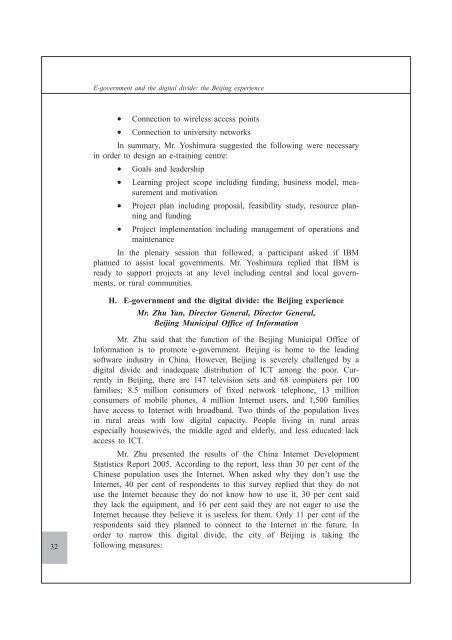Designing e-Government for the Poor - Tanzania Development ...
Designing e-Government for the Poor - Tanzania Development ...
Designing e-Government for the Poor - Tanzania Development ...
You also want an ePaper? Increase the reach of your titles
YUMPU automatically turns print PDFs into web optimized ePapers that Google loves.
32<br />
E-government and <strong>the</strong> digital divide: <strong>the</strong> Beijing experience<br />
• Connection to wireless access points<br />
• Connection to university networks<br />
In summary, Mr. Yoshimura suggested <strong>the</strong> following were necessary<br />
in order to design an e-training centre:<br />
• Goals and leadership<br />
• Learning project scope including funding, business model, measurement<br />
and motivation<br />
• Project plan including proposal, feasibility study, resource planning<br />
and funding<br />
• Project implementation including management of operations and<br />
maintenance<br />
In <strong>the</strong> plenary session that followed, a participant asked if IBM<br />
planned to assist local governments. Mr. Yoshimura replied that IBM is<br />
ready to support projects at any level including central and local governments,<br />
or rural communities.<br />
H. E-government and <strong>the</strong> digital divide: <strong>the</strong> Beijing experience<br />
Mr. Zhu Yan, Director General, Director General,<br />
Beijing Municipal Office of In<strong>for</strong>mation<br />
Mr. Zhu said that <strong>the</strong> function of <strong>the</strong> Beijing Municipal Office of<br />
In<strong>for</strong>mation is to promote e-government. Beijing is home to <strong>the</strong> leading<br />
software industry in China. However, Beijing is severely challenged by a<br />
digital divide and inadequate distribution of ICT among <strong>the</strong> poor. Currently<br />
in Beijing, <strong>the</strong>re are 147 television sets and 68 computers per 100<br />
families; 8.5 million consumers of fixed network telephone, 13 million<br />
consumers of mobile phones, 4 million Internet users, and 1,500 families<br />
have access to Internet with broadband. Two thirds of <strong>the</strong> population lives<br />
in rural areas with low digital capacity. People living in rural areas<br />
especially housewives, <strong>the</strong> middle aged and elderly, and less educated lack<br />
access to ICT.<br />
Mr. Zhu presented <strong>the</strong> results of <strong>the</strong> China Internet <strong>Development</strong><br />
Statistics Report 2005. According to <strong>the</strong> report, less than 30 per cent of <strong>the</strong><br />
Chinese population uses <strong>the</strong> Internet. When asked why <strong>the</strong>y don’t use <strong>the</strong><br />
Internet, 40 per cent of respondents to this survey replied that <strong>the</strong>y do not<br />
use <strong>the</strong> Internet because <strong>the</strong>y do not know how to use it, 30 per cent said<br />
<strong>the</strong>y lack <strong>the</strong> equipment, and 16 per cent said <strong>the</strong>y are not eager to use <strong>the</strong><br />
Internet because <strong>the</strong>y believe it is useless <strong>for</strong> <strong>the</strong>m. Only 11 per cent of <strong>the</strong><br />
respondents said <strong>the</strong>y planned to connect to <strong>the</strong> Internet in <strong>the</strong> future. In<br />
order to narrow this digital divide, <strong>the</strong> city of Beijing is taking <strong>the</strong><br />
following measures:

















